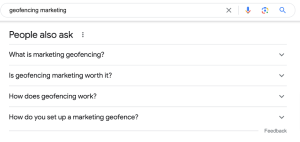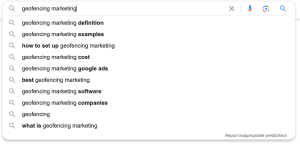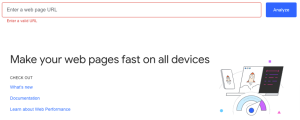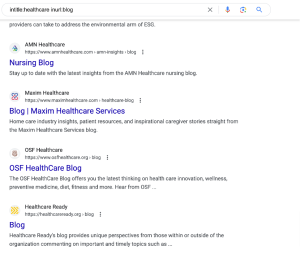Introduction To Search Engine Optimization (SEO)
Search Engine Optimization is a practice that’s been around for 25-plus years. With major search engines including Google, Yahoo, and Bing/Microsoft becoming the top places for commerce and growth for brands, one’s ability to rank organically and get free website traffic is a level of currency you can’t put a dollar figure on.
Growing organic search engine traffic to your website is one thing. But getting your desired traffic for the keywords that have the highest commercial intent for your brand and your business is another process that requires patience, an understanding of what the search engines want, knowing your competition, and showcasing your business as having the most authority and relevance via the keywords searchers are typing into the search engines.
In this guide, we will break down SEO into seven (7) areas:
- Fundamentals Of SEO
- On-Page SEO
- Technical SEO
- Local SEO
- Competitor Analysis
- Content Marketing
- Link Building, Marketing & Promotion
As you read through this SEO Company Guide, remember that SEO is about feeding the search engines what they want, giving searchers what they want, providing a good user experience for the searchers, and ensuring your website and its content are being given a thumbs up by other websites, otherwise known as backlinks.
There are advanced aspects of Search Engine Optimization (SEO) we discuss in this guide. Still, suppose you are a local or national brand owner or even a marketing director. In that case, you will know what to look for and how to hold other SEO Agency Companies accountable, whether outsourcing the SEO Company work or doing it in-house.
Key Fundamentals of Search Engine Optimization (SEO)
Before we get into the more tactical areas of search engine optimization (SEO), we want to break it down to a sheer marketing level.
Be sure to complete this section. The rest doesn’t matter if you don’t understand SEO at the core marketing and consumer behavior level. The four points below are vital to being effective and excelling at SEO.
SEO = Answering Questions & Providing Value
If the goal with SEO is to optimize your website for search engines, the unspoken objective is to optimize your website for people, searchers, and what they need answers to. Nothing is more frustrating for a consumer who visits a website that doesn’t find what they need or doesn’t get answers to the fundamental questions they need.
Remember that when a searcher visits Google, Yahoo, or Bing, they only spend 60 seconds or less on one of those search engines. So, ensuring your website is optimized for the user and providing answers to questions centered around the searcher becomes even more critical. Here are some tips we suggest for brands to make both search engines and people happy after visiting your website:
-
- Build out landing pages full of pertinent information
- Consider all the questions centered around the search query
- Break up the content to create a good user experience (bullet points, design elements, video, images, etc.)
- Ensure the search query (keywords) is spread throughout the website and landing pages
We will discuss more of this in future sections of the SEO agency guide, but building websites based on value and user experience will inherently land you in better graces with consumers.
E-A-T (Expertise, Authoritativeness & Trustworthiness)
To establish a successful website and gain people’s trust, showcasing your knowledge and authority is crucial. It’s not just about creating a website or publishing a blog post with some tips. You need to demonstrate your expertise and make it evident through your content. Let your knowledge shine and prove your credibility to your audience.
A pro tip is searching via your top keywords and seeing what your competition is saying on their websites. Are their websites thin on content? Are they answering questions you didn’t think about initially? Is their menu navigation more straightforward for consumers to locate information? Are the websites filled with helpful videos? This strategy will help generate ideas to showcase your expertise and authority in your space.
During our marketing research, we discovered that some people searched for information on geofencing costs, types, and competitors. Google provided a list of additional questions people are searching for answers to. See the example below.
Keyword Research Proficiency
This topic deserves an entire course by itself. We did a video on conducting keyword research here. We perform keyword research for SEO and Paid Ads for Google and Microsoft Ads. You can tap into several tools, but conducting keyword research before any SEO is critical. It typically starts with the seed keywords you believe your brand is relevant to, but those seed keywords can help sprout many other terms that are tangentially relevant to the original keyword terms you had in mind.
It’s common for brands to make the mistake of focusing on ranking for keywords that consumers don’t frequently search. This can be exacerbated when SEO agencies claim to have achieved rankings for specific keywords with low commercial intent or search volume purely because of limited competition for those terms. However, the reality is that it can be deceiving to assume that having successful SEO and generating website traffic will automatically translate into increased phone calls, appointments, leads, or sales. Some of our favorite tools for keyword research include:
-
- Google Keyword Planner – Utilize Google’s own Keyword Planner to discover keywords, get search volume data, and generate keyword ideas. It’s part of Google Ads and is free to use.
- SEMrush – SEMrush is a versatile SEO tool that offers robust keyword research features, including competitor analysis, keyword difficulty, and related keyword suggestions.
- Ahrefs – Ahrefs provides comprehensive keyword research capabilities, including search volume, keyword difficulty, and the ability to explore competitor keywords and backlinks.
- Moz Keyword Explorer – Moz’s Keyword Explorer offers insights into keyword difficulty, search volume, and click-through rates. It also provides valuable suggestions for related and long-tail keywords.
- Ubersuggest – Ubersuggest is a free tool that provides keyword suggestions, search volume, and competition data. It also offers insights into content ideas and competitor analysis.
- AnswerThePublic – AnswerThePublic visualizes search query data to provide content ideas and keyword suggestions based on user questions and phrases.
- KeywordTool.io – KeywordTool.io helps you discover long-tail keywords by generating autocomplete suggestions from various search engines, including Google, Bing, and YouTube.
- SpyFu – SpyFu allows you to spy on your competitors’ keywords, ad strategies, and ranking history. It provides valuable insights for refining your own keyword strategy.
- Long Tail Pro – Long Tail Pro specializes in finding long-tail keywords, helping you identify less competitive and more specific search terms.
- Google Trends – Google Trends shows the popularity of search terms over time, helping you identify trending topics and seasonality in search behavior.
- Keyword Surfer (Chrome Extension) – Keyword Surfer is a handy Chrome extension that provides search volume and keyword suggestions directly in the Google search bar.
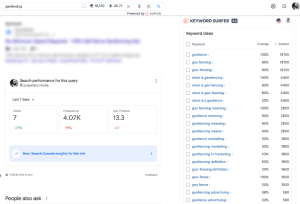
Our tool of choice is Keyword Surfer, which is a free Chrome extension. But keyword research is a critical fundamental first step in effective SEO Company strategy, whichever tool you choose.
Your Customer Journey Research
The final key area in SEO before starting any other aspects of Search Engine Optimization execution involves understanding your customer journey and getting those questions answered as they go throughout that journey. I previously gave a short example of geofencing marketing, but let me give another.
For example, suppose you are a brand in search of presentation software. In that case, that software company may want to think through the various iterations of a customer journey and what that consumer may go through before making a decision.
With almost ten years of industry knowledge and expertise, this is how I would try to map out the plan:
- Searcher realizes his team, or himself, needs a more robust presentation software solution
- Imagine all the problems that solution must solve for
- Determines if he has the budget or funds to pay for such software
- Begins to research a bunch of competitors and look at key offerings
- Wonders which presentation software providers integrate with his company’s key communication channels like Slack, Microsoft Teams, Monday.com, or Click Up.
- How long does it take to onboard the presentation software?
- He wonders how much time the new software will save his team.
- Is there an app to download for both MAC and Microsoft laptops? How about tablets?
- How about design features?
- Can I import old presentations into the new software with ease?
- What learning modules or quick starter videos are available so our team can hit the ground running fast?
These are all BDQs (Buyer Decision Questions). And if I’m a new presentation software company, I’m getting all the questions, and then some of the above answered creatively via my website. The more these questions are responded to and addressed via blog content and your website, the better you’ll show that level of authority, expertise, and trustworthiness.
If you’ve integrated these fundamental SEO principles into your strategy, the rest of this SEO agency marketing guide will become even clearer when creating an effective SEO company strategy.
On-Page Optimizations For An SEO Agency
In the first section, we discussed the fundamentals of SEO and how to view search engine optimization. Maintaining a marketer’s mindset and understanding the customer experience is critical to SEO efforts.
In the constantly evolving world of digital marketing, on-page SEO remains a crucial element for improving a website’s visibility in search engine results. According to an industry study by Ahrefs, on-page SEO makes up roughly 20% of all ranking factors. This means optimizing your website’s meta tags, headers, content, URL structure, and other on-page elements can significantly impact your search engine rankings. By implementing effective on-page SEO strategies, businesses can enhance rankings, attract targeted traffic, and improve the overall user experience. So, let’s take a closer look at the top on-page SEO strategies you can use to optimize your website for search engines.
Keyword Research and Placement
We discussed this a lot in the fundamentals section above, but let us begin with thorough keyword research to identify relevant terms for your content. You must strategically place primary keywords in your page’s title, meta description, headers (H1, H2), and throughout the content.
Your content must sound simple and natural, as if it were made for humans rather than robotic search engines. To achieve this, try to integrate your keywords in a way that feels natural and doesn’t disrupt the flow of the text. This means balancing using the right keywords to improve your rankings and avoiding the temptation to overuse them. By doing so, you’ll be able to create content that is both readable and optimized for search engines.
Optimize Title Tags and Meta Descriptions
Write captivating title tags that accurately reflect your content and include target keywords. Those target keywords must be included in your title tags and meta descriptions. Your website’s content is the main way search engines understand its purpose and topic.
It is best to craft concise and engaging meta descriptions that encourage clicks by providing a brief overview of your page’s content while incorporating the main keywords centered around that page and its content.
Header Tags (H1, H2, H3) for Content Structure
Header tags (H1, H2, H3) are also recommended to structure your content logically. Search engines look at H Tags as added signals to what your content is about, so having intriguing keyword-rich H Tags that make sense will improve search traffic and readability of your website and content.
Header tags make your content more readable and help search engines understand the hierarchy and importance of different sections. It also is helpful for readers as they go through your content.
URL Optimization
It’s important to create URLs that are both clean and SEO-friendly. This means incorporating relevant keywords while avoiding lengthy or confusing URLs. Instead of using URLs that are full sentences, it’s best to opt for short, descriptive ones that give users and search engines a clear idea of the page’s content.
In addition, it’s equally important to add your primary keywords to the URL of your pages. By doing this, you add an extra layer of relevance for both users and search engines, which can improve the overall visibility and ranking of your website.
Image Optimization
Search engines like Google can index images and determine what they represent. Therefore, it’s crucial to choose proper names for your images to optimize them. To do this, use descriptive file names and add relevant alt-image text. Creating a 3-6 word phrase to describe your image can improve its ranking and add relevance to your content pages. This not only enhances accessibility but also presents an opportunity to include additional keywords that are relevant to your website.

Internal Linking
Incorporating internal links within your website to connect relevant pages is important. This not only improves navigation but also helps search engines understand the structure of your site and distributes link
authority. Interlinking landing pages and blog posts with proper anchor text is a minimum requirement to pass link juice (ranking opportunities) and keyword relevance specific to your URLs. It is worth noting that anchor text distribution is equally important.
User-Friendly URL Structure
Maintain a user-friendly URL structure that reflects the hierarchy of your site. Clear and intuitive URLs contribute to a positive user experience and are favored by search engines. On-Page SEO Optimization is a lengthy process that requires auditing an entire website, conducting keyword research, potentially optimizing landing pages and content blog pages, and ensuring keywords are peppered in the right places.

But if your website cannot be crawled, on-page SEO becomes even more challenging. So, in the next section, we will discuss the aspects of technical SEO.
Technical SEO: Is Your Site Fast and Crawlable?
Now that we have discussed On Page SEO For Companies, we must ensure search engines can crawl your website.
According to a survey by SEMrush, technical SEO accounts for approximately 28% of all ranking factors. This highlights the significance of ensuring that your website’s technical aspects are optimized to drive organic search traffic and improve search engine rankings.
Technical SEO is the process of ensuring your website can be crawled and that the technical aspects of your website are aligned with what makes the search engines happy. Technical SEO principles include website speed, crawlability, indexation, keeping duplicate content to a minimum, schema markup, and more.
Here are the key areas we recommend focusing on around technical SEO for brands…
Perform An SEO Agency Audit
SEO Agencies are critical in search engine optimization for brands and website owners. The very first thing an SEO agency will do after meeting with the brand is conduct a Search Engine Optimization audit. Within that, there is an on-page SEO audit, content audit, keyword audit, link audit, and technical SEO audit. SEO Companies will conduct a lot of it manually, and some will utilize tools to determine the technical SEO health of your website.
These are some of our favorite tools, but again, these require a deep understanding of technical SEO:
-
- Google Search Console – Google’s tool provides valuable insights into your website’s performance, indexing status, and search queries. It’s an essential starting point for any SEO audit. And it’s, in fact, a requirement by most SEO Agencies, including Propellant Media.
- SEMrush – SEMrush is a comprehensive SEO suite offering site audit capabilities. It provides detailed reports on issues affecting your site’s health, backlink profile, and on-page SEO.
- Ahrefs – Ahrefs is known for its robust backlink analysis, but it also includes a Site Audit tool that helps identify SEO issues, monitor site health, and improve overall performance.
- Moz Pro – Moz’s Site Crawl tool is part of Moz Pro, offering insights into on-page SEO issues, crawlability, and site performance. It provides actionable recommendations for improvement.
- Screaming Frog SEO Spider – This desktop-based tool crawls websites to identify common SEO issues such as broken links, duplicate content, and missing meta tags. It’s beneficial for technical SEO audits.
- Sitebulb – Sitebulb is an SEO auditing tool that provides in-depth reports on technical SEO issues, content quality, and site performance. It’s known for its user-friendly interface.
- DeepCrawl – DeepCrawl is a cloud-based website crawler that offers insights into technical SEO issues, duplicate content, and site structure. It’s suitable for large and complex websites.
- Raven Tools – Raven Tools includes a Site Auditor that analyzes your website for SEO issues, providing clear reports and recommendations for improvement.
- Woorank – Woorank is a website review tool that assesses on-page and technical SEO elements, providing a score and actionable recommendations for optimization.
- Majestic SEO – While primarily known for backlink analysis, Majestic also offers a Site Explorer tool that provides insights into your website’s structure, link profile, and overall health.
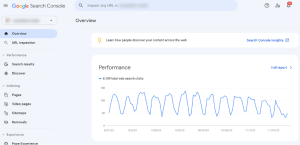
Speed Up Your Website…It’s A Ranking Factor
Have you ever conducted a Google search and visited a website, but upon clicking on the site, it took over 15 seconds for the page to load? That’s an eternity for most people. That’s all about user experience and ensuring searchers can find the answers to their questions seamlessly and quickly.
According to recent data from Google, the average mobile webpage takes around 15 seconds to load. However, research shows that 53% of mobile users will abandon a website that takes longer than 3 seconds to load. Therefore, having a fast-loading website is essential for delivering a positive user experience and reducing bounce rates. So, if Google is paying attention to page speed load times, they are factoring it into how high you should rank for specific keywords. Here are the top page speed load factors:
-
- Images and Videos – Are the file sizes too big?
- Server Speed – Do you have a fast server?
- CMS Platform – Is your CMS platform underperforming?
- JavaScript and CSS – Is CSS or Javascript slowing down your landing pages?
To determine your page speed and other insights, below is a list of tools to consider:
-
- Google PageSpeed Insights – Google’s PageSpeed Insights provides a detailed analysis of your website’s performance on desktop and mobile devices. It offers suggestions for improvement and assigns a score based on various performance metrics.
- GTmetrix – GTmetrix analyzes your website’s loading speed and provides a comprehensive report with actionable recommendations. It includes metrics such as PageSpeed Score, YSlow Score, and fully loaded time.
- Pingdom Website Speed Test – Pingdom offers a user-friendly speed test tool that provides insights into your website’s performance, including load time, page size, and the number of requests. It also allows you to test from different geographic locations.
- WebPageTest – WebPageTest allows you to test your website’s performance from different browsers and locations. It provides a detailed breakdown of loading times, requests, and suggestions for improvement.
- Lighthouse (Chrome DevTools) – Lighthouse is an open-source, automated tool for improving the quality of web pages. It’s integrated into Chrome DevTools and provides audits for performance, accessibility, progressive web apps, SEO, and more.
- YSlow – YSlow YSlow is a browser extension that analyzes web pages to determine their performance and suggests ways to improve their speed and overall performance.
- PageSpeed Ninja – PageSpeed Ninja is an online tool that analyzes your website’s performance and provides recommendations for optimization. It offers a simple and intuitive interface.
Image and Video SEO
Plenty of videos on ensuring image and video SEO are in order. However, here are the key tips my experts have for you:
- Add optimized keywords to both the alt image tag and file title of the image
- Ensure the image is not a large file size over 500 kb
- Ensure the image is relevant to the content and the page
- Ensure it can, in fact, be indexed
There is much more to Technical SEO than these points, but this is a good starting place to determine how to implement effective technical SEO for companies and web admins.
Local SEO (Ranking Locally In Map Listings and More)
Local SEO is the practice of optimizing a business’s website to appear in local map packs and organic search listings in the local geographic regions. According to a study by Moz, Google My Business signals play a significant role in local pack rankings, accounting for 25% of the total ranking factors. These signals include the proximity of the business to the searcher’s location, the business category’s relevance, and the business’s prominence (determined by factors such as the total number of reviews and ratings). This highlights the importance of updating and ensuring the accuracy of your Google My Business listing.
Local SEO can be used by any business with local intent, from restaurants and lawyers to hospitals and retailers. Compared to e-commerce, online publications, and B2B software technology brands that may have clients nationally, local SEO is a process specific to local businesses.
There are several local signals to consider when ranking for local keywords. This article will discuss the philosophy behind these signals and the most important ones to focus on.
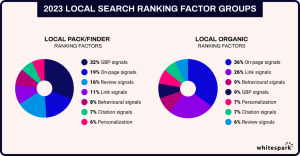
Local Intent Keywords
Google and other search engines have done a fascinating job distinguishing between the intent of a searcher and the SERPs that those search engines want to populate for searchers. Take the term “personal injury lawyer.” Most people are not performing a search for a PI attorney in Chicago if that searcher lives in Atlanta…unless they add the word Chicago to the search query. So Google and other search engines will mostly show brands in Chicago who are PI Attorneys.
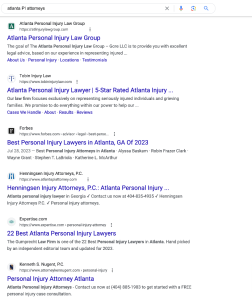
As a local brand, adding city- and state-based keywords to your website and key landing pages will significantly impact your search engine and local map listing rankings.
Google My Business (GMB)
The first step is optimizing your Google My Business listing. All businesses with local intent can claim their listing. This includes receiving a postcard sent to your commercial address to confirm your existence, adding a full description to your listing, identifying your service categories, images, videos, and more. Bing (Microsoft) has an equivalent called Bing Places, which is very similar and which you should also take advantage of.
Visit this link to ensure you have claimed your listings in Microsoft and Google.
Name Address Phone Number (NAP) Consistency
How consistently your business name, address, and phone number appear on other listing websites adds to relevancy and trustworthiness. Some SEO brands choose to do this work manually. But some websites can help in the process, including:
-
- Yext
- Loganix
- Moz Local
- Uberall
- Synup
Reviews At Scale
Another critical local SEO trust signal is reviews. It may seem obvious to some, but getting Google reviews across your Google My Business listing and other top listing pages will add trustworthiness and help you rank higher for those local terms. Below are examples of platforms to work to make it more seamless for your customers to leave you reviews:
-
- 7ReviewTrackers – ReviewTrackers is a dedicated review management platform that helps businesses collect, manage, and analyze customer reviews from various sources, including popular review sites.
- BirdEye – BirdEye is a comprehensive online reputation management tool that enables businesses to collect reviews, monitor social media, and gain insights into customer sentiment.
- Trustpilot – Trustpilot is a widely recognized review platform that allows businesses to collect and showcase customer reviews. Positive Trustpilot reviews can enhance your brand’s trustworthiness.
- Podium – Podium offers tools for managing customer reviews and online interactions. It includes messaging, web chat, and online review management to streamline customer communication.
- GetFiveStars (GatherUp) – GetFiveStars is a customer feedback and online review platform that automates the process of collecting reviews. It also helps businesses monitor and manage their online reputation.
- Reputation.com – Reputation.com provides a comprehensive solution for online reputation management, including review monitoring, sentiment analysis, and the ability to respond to reviews from a centralized platform.
Backlinks To Your Website (Local & Relevant)
Another critical signal discussed in an upcoming section is links to your website. In the world of SEO, we call it link building. But said differently, links add relevance and authority to your website. The more links you get, the more Google determines your website as being more trustworthy and authoritative. Think of links as votes of confidence from other websites. And the more authoritative and relevant you get, the better.
Local SEO is more involved than this, but these are the initial building blocks to developing a solid local SEO game plan.
Reverse Engineer And Research Your Competition
We’ve discussed conducting research on your competitors throughout this guide, but it truly deserves its section.
In most cases, you will need to research and understand who your SEO competition is. And that’s not simply brands you compete with head to head for business, but those who rank for the keywords you want to rank for in the search engines.
Below is a suggested process for conducting SEO research on your competition.
Conduct Contender Keyword Research
Use keyword research tools like Google Keyword Planner, SEMrush, Keyword Surfer, or Ahrefs to identify the keywords your competitors are targeting. Look for high-volume and relevant keywords that are driving traffic to their website. And see which of those terms your competitors are ranking for.
Identify Your Competitors
When conducting Google searches to understand your top keywords and want to rank for them, it’s a good idea to make a list of your main competitors in the industry or niche. Look at the competitors who are ranking for those terms in the organic listings and not in Google Sponsored Ads.
By doing this, you will be able to identify the companies that are ranking for your main keywords. Visit their landing pages to see what you like and dislike about their webpages. This will give you more insights on how you can effectively compete against them.
Analyze Competitor Websites
Analyzing competitor websites is a crucial step in developing a successful online strategy. By understanding the strengths and weaknesses of your competitors’ websites, you can identify opportunities to improve your site and gain a competitive edge. This process involves evaluating various aspects of their website, such as their design, user experience, content, search engine optimization, and social media engagement. The insights gained from analyzing your competitor’s websites can help you make informed decisions about how to improve your website and attract more visitors, leads, and customers. When analyzing your competitors’ websites, we recommend paying close attention to the following elements:
- Page titles and meta descriptions: Look for the keywords they are using in their page titles and meta descriptions.
- URL structure: Analyze how they optimize their URLs with keywords and maintain consistency.
- Content quality and structure: Evaluate the quality and structure of their content. Look for the use of headers, subheadings, and bullet points to enhance readability and keyword optimization.
After you’ve conducted your competitor research, you will far better know your SEO competition, what about their websites are and are not appealing, what keywords they’re talking about, and even what content they’re writing about.
Don’t take the position that simply because your competitors are writing about specific topics you shouldn’t. You need to compete, and the way to do that is to do it better than your competition at volume and scale, answering the key questions critical to potential searchers. Remember, Google provides clear hints as to what searchers need answers to. Take advantage of the moment and walk into your spotlight.
Build Your Content Marketing Strategy
We’re not simply discussing your website and its product/service pages. Those, too, can be important and should be part of your content marketing plan. But we’re talking about your blog and writing helpful content that increases search traffic.
This is the top means of driving brand SEO traffic. Even enterprise-level organizations are doing content marketing and blogging. But there is a defined process you should go through. Some of it is mentioned in other sections of this SEO guide, but this is how we define the process.
Define Your Content Marketing Goals & Target Audience
Determine the objectives you want to achieve through content marketing (e.g., brand awareness, lead generation). Next, you must identify your target audience and understand their needs, interests, and preferences. This part of the process will assist you with coming up with more content ideas and understand the type of content you want to develop based on your target audience and your marketing objectives.
Conduct Thorough Keyword & Competitor Research
To create a strong content marketing plan, conducting thorough research is essential. This includes analyzing industry trends, assessing the competitive landscape, and studying audience behavior. By doing so, you can identify popular topics, relevant keywords, and compelling content formats that will resonate with your target audience. While we’ve discussed the importance of keyword and competitor research before, we must place emphasis on taking the time to research and gather insights thoroughly. that will inform your content creation and distribution efforts.
Create A Content Strategy
Set clear objectives, KPIs, and a content calendar to guide your efforts. Determine the types of content you will create (blogs, videos, infographics, etc.) and their distribution channels (website, social media, email). Plan for content promotion and distribution to reach your target audience effectively.
Develop High-Quality Content
Produce engaging and valuable content that addresses your target audience’s pain points and provides solutions. Use a mix of formats (text, visuals, multimedia), storytelling techniques, and compelling headlines to capture attention. Ensure your content is well-researched, accurate, and original.
Optimize Content For SEO Companies
Incorporate relevant keywords naturally throughout your content. Optimize meta tags, headers, and URLs to improve search engine visibility. Include internal and external links to improve website authority and user navigation.
Promote Your Content
Utilize various channels (social media, email marketing, influencer partnerships) to promote and distribute your content. Engage with your audience through comments, shares, and likes to encourage interaction and increase reach. Consider paid advertising or content distribution platforms for wider exposure.
Measure And Analyze Results
Track the performance of your content marketing efforts using analytics tools (e.g., Google Analytics – GA4). Measure key metrics such as website traffic, engagement, conversion rates, and ROI. Use the data to identify what works and needs improvement and make data-driven decisions for future content marketing strategies.
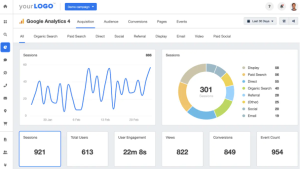
Remember that effective content marketing requires consistent effort, quality content creation, and continuous optimization based on data and audience feedback.
Marketing, Link Building & Website Promotion
SEO Agency Companies may call it link building, but we like to call it marketing and promotion. One’s ability to get your website and content exposure will translate into links, traffic, and exposure to your website.
Instead of going through the philosophy of link building and marketing your website, let us first say that links are the biggest ranking signal within the search engines. As stated in a prior section, links are like votes of confidence. You can get links from websites with low and higher domain authority.
According to a study by SEMrush, the number of referring domains (websites linking to a webpage) is a strong ranking factor correlated with higher positions in search engine results. The study analyzed over 600,000 search queries and found that, on average, the top three ranking pages had significantly more referring domains compared to pages in lower positions.
For the sake of marketing, link building, and website promotion, here are our quick tips for building links and promoting your website to attract more links.
Create High-Quality Content
We created an entire section around this, but there are many different forms of quality content, even down to your home page and product and service pages.
Develop valuable and shareable content that naturally attracts links. Content that solves problems provides unique insights, or entertains is more likely to be linked to other websites.
Guest Blogging
Contribute high-quality guest posts to reputable websites in your industry. This not only establishes you as an authority but also allows you to include backlinks to your own site.
So, How do you find guest blog posts? Perform the following samples of searches in Google that include the word “blog” in the URL and your industry in the title, and several will show up:
- Healthcare Blogs: intitle:healthcare inurl:blog
- Legal Blogs: intitle:lawyer inurl:blog
- Finance Blogs:intitle:finance inurl:blog
Please note that if you go down this path, avoid picking the blogs on the first page of Google, as those may be more challenging to post on. Instead, start checking page 2 and beyond.
Broken Link Building
Identify broken links on other websites, particularly those related to your content. Reach out to the website owner, inform them of the broken link, and suggest your content as a replacement.
Build Relationships With Other Webmasters & Partners In Your Space
Cultivate relationships with influencers, bloggers, and other businesses in your industry. Genuine relationships can lead to natural link opportunities.
As an example, our agency does not do web design or development. So we have partners in the space we trust that outsource to. We link to them from our website. And they in turn link back to us.
Now we not suggesting you create a big link farm of partners you randomly link to, but having a few partners along with other web admins remains an effective link building and promotional strategy for your brand.
Utilize Social Media
Share your content on social media platforms to increase its visibility. While social signals don’t directly impact SEO, increased visibility may lead to more backlinks.
Some of the better platforms for social media exposure include X (formerly Twitter), LinkedIn, Facebook, and Instagram.
Leverage The Skyscraper Technique
This was first created by the company Backlinko. Identify popular content in your niche, create even more valuable and comprehensive content, and then reach out to websites that linked to the original content, suggesting they link to yours.
Now, what’s the best way to accomplish this? Determine what questions their content is not answering, then provide everything they provide plus the gaps you find. This tried and true technique continues to work to this day. The big point is that your content must be relevant and consist of more words than theirs in most instances. That coupled with an effective link building strategy will help that content skyrocket.
Infographics & Visual Content
Create visually appealing infographics or other shareable visual content. People often link to and share visual content, providing an opportunity for natural link-building.
Resource Pages
Find resource pages in your industry that list useful tools, articles, or websites. Reach out and suggest your content as a valuable addition to their resource list.
You can also do it in reverse. Create a resources page that may be industry-specific, thus creating content that is likable from other brands and websites.
Collaborate On Roundup Posts
This remains one of my favorite strategies.
Participate in or host industry roundup posts where experts in your industry share their insights on a topic or question. This can lead to natural backlinks when participants share the post.
This is similar to ego bait but instead you’re picking a topic or a set of topics within a theme. And you’re asking influencers who have knowledge on that topic. They then provide answers and then once the post is complete, you share with them. They will 8 times out of 10 share with their followers and even link to it from their website.
Local Citations
Ensure your business is listed accurately on local directories and platforms. Things all part of the local SEO strategies we laid out above, but even if you’re a national brand with national reach, building local citations in the city in which your brand was founded can be powerful.
Local citations can contribute to local SEO and provide valuable backlinks. As mentioned, there are powerful platforms like Yext and Moz Local that can assist with this.
Ego Bait Content
Another effective content strategy is to feature and praise other businesses, influencers, or experts in your industry. By mentioning them in your content, you can increase the chances of them sharing or linking to your content.
To make this strategy work, it’s best not to ask for permission. Create the content and then reach out to the mentioned parties via email or social media with a link to the mention. In most cases, they will be happy to share it with their followers and expand your content’s reach.
Of course, it’s important to ensure that the content you create is genuine and valuable. Don’t just mention others for the sake of getting their attention. Instead, focus on creating content that delivers real value to your audience. By doing so, you’ll not only increase the chances of others sharing your content, but also establish yourself as a thought leader in your industry.
Contribute To Q&A Platforms
Participating in Q&A platforms such as Quora can be a great way to drive traffic to your website while also building your online presence. By providing valuable and insightful answers to questions related to your industry, you can establish yourself as an authority in your field and attract potential customers to your website.
Additionally, Q&A platforms are often highly ranked by search engines, which can help improve your website’s visibility and generate backlinks. Therefore, it’s worth considering contributing to Q&A platforms as part of your marketing strategy.
Build A Useful Tool
At Propellant Media, we understand the importance of having useful tools that can help people in their everyday lives. That’s why we developed a CPM Calculator that makes it easy for anyone to calculate their budget and total impressions. Our calculator not only ranks well, but it has also proven to be a valuable resource for site visitors. If you’re looking for a reliable tool to help you make informed decisions about your advertising strategy, then our CPM Calculator is the perfect solution.
One of the best things about our CPM Calculator is that it only requires a little web development resources to implement. Despite this, it continues to attract links and bring value to our website visitors.
This is a testament to the quality of our tool and the level of care we put into its development. If you’re interested in learning more about our CPM Calculator and how it can help you achieve your advertising goals, please visit our website at https://propellant.media/cpm-calculator/. We’re confident that you’ll find our tool an invaluable resource you can rely on for years to come.
Provide Testimonials
Provide testimonials for products or services you’ve used. We have done this for a number of brands and partners we’ve done business with. In return, you may receive a backlink from the company’s website
List Your Competitors Via A Blog Post On Your Website
Listing your competitors on your website through a blog post may seem controversial. However, it can be beneficial as potential clients often search for companies to work with. For example, if your company specializes in geofencing marketing like Propellant Media, you can create a blog post highlighting the top 30+ competitors in the same field. This can establish your expertise in the industry and provide valuable information to potential clients.
As a result, that page ranks on the first page of Google for keywords such as geofencing companies, geofencing agencies, etc..
Furthermore, I recommend listing all your local competitors if you are a local company. I know it seems controversial, but just think that traffic you would not have gotten anyway. And people who visit your website are not going to your blog and reading all your blog posts. They are visiting you for the first time from the original blog posts you created. So you could take advantage of that traffic, even if they consider visiting your competition.
Consider Adding Google Ads To Your Marketing Mix
I love Google Ads because it gives us insights beyond Google’s Keyword Planner. it allows you to get traffic immediately to your website, but more importantly, you can see what keywords translating into sales, traffic and leads.
One of the ways that Google Ads can indirectly impact SEO is through the concept of “brand lift.” Brand lift refers to the increase in organic search traffic and brand-related searches that occur as a result of running Google Ads campaigns. According to Google, businesses that run paid search ads see an average increase of 89% in top-of-mind awareness compared to businesses that solely rely on organic search results. Running Google Ads can help increase brand visibility, recognition, and overall brand awareness, which can positively impact organic search traffic and SEO efforts.
You can deploy a small budget to get started with Google Ads. But the insights and keyword knowledge you get on day one of launching such a campaign can fuel your insights for your Search Engine Optimization efforts.
SEO Conclusion And Parting Thoughts
Attracting traffic to your website is a long-term game that requires a multi-pronged approach. While paid ads can be effective, direct traffic and organic search are two areas that can naturally bring visitors to your site. Investing in Search Engine Optimization (SEO) is critical to ensuring that your website ranks highly in search engine results pages, which in turn will attract more searchers and prospects to your site. All the points mentioned in this guide are part of the ranking signals leading to increased organic traffic.
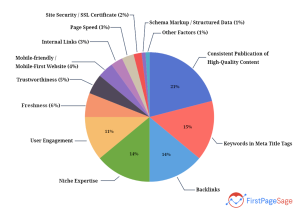
However, SEO is not a quick fix, nor is it a process that can be completed in a matter of months. Instead, it requires constant evaluation of your product and service pages, promotion of your website, and creation of new services and blog content.
This ongoing effort is what makes SEO one of the most vital areas of growth and revenue generation for brands and SEO agencies alike.
Ultimately, the key to improving your search traffic is to build a website and content with the searcher in mind. Consistently thinking of ways to add value to your site visitors will indirectly improve your search traffic. This means developing new ideas for services, creating new service pages, and promoting your website through a variety of channels.
Remember, SEO is a long game that requires patience, persistence, and a commitment to ongoing improvement.


